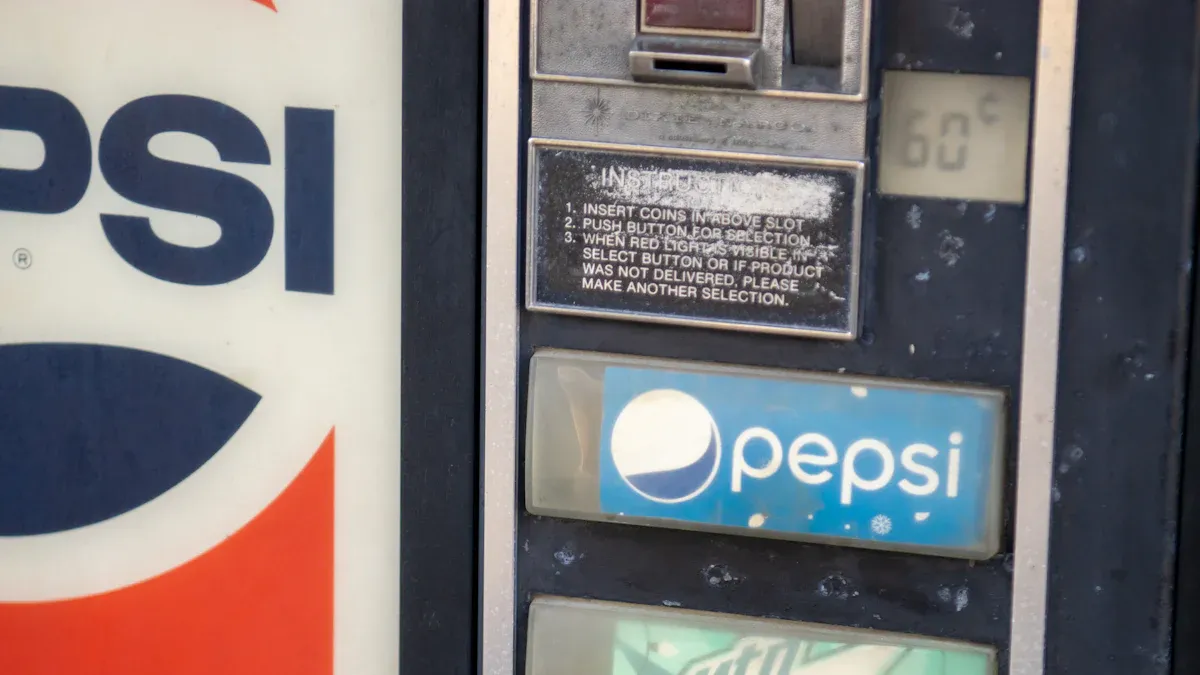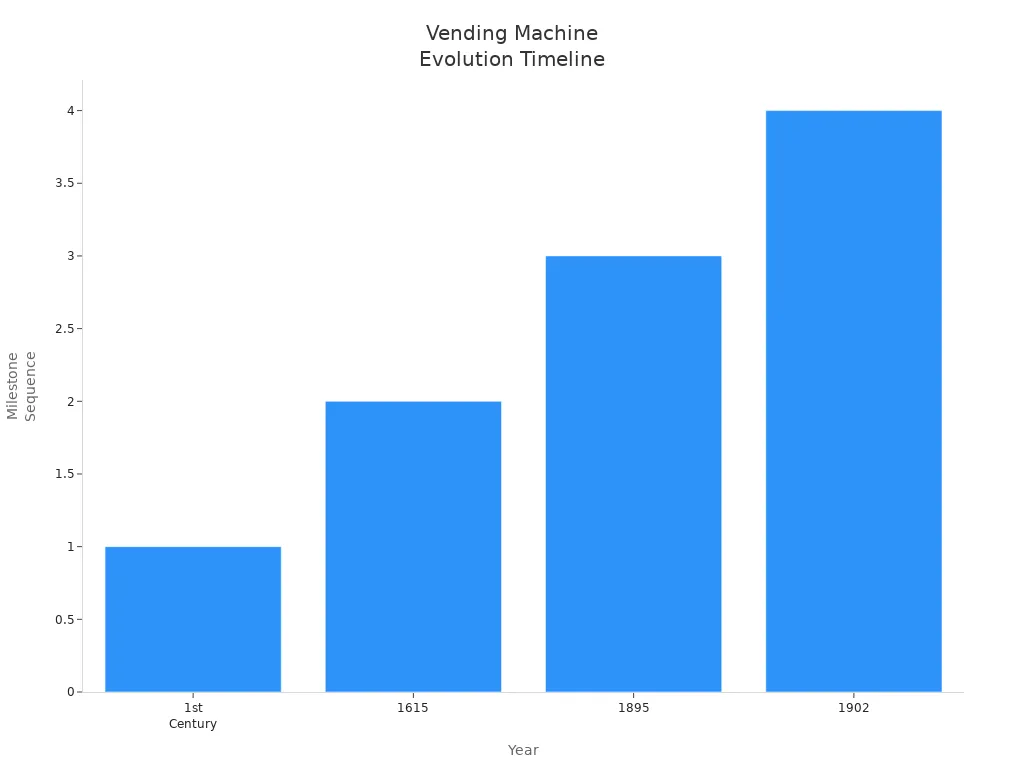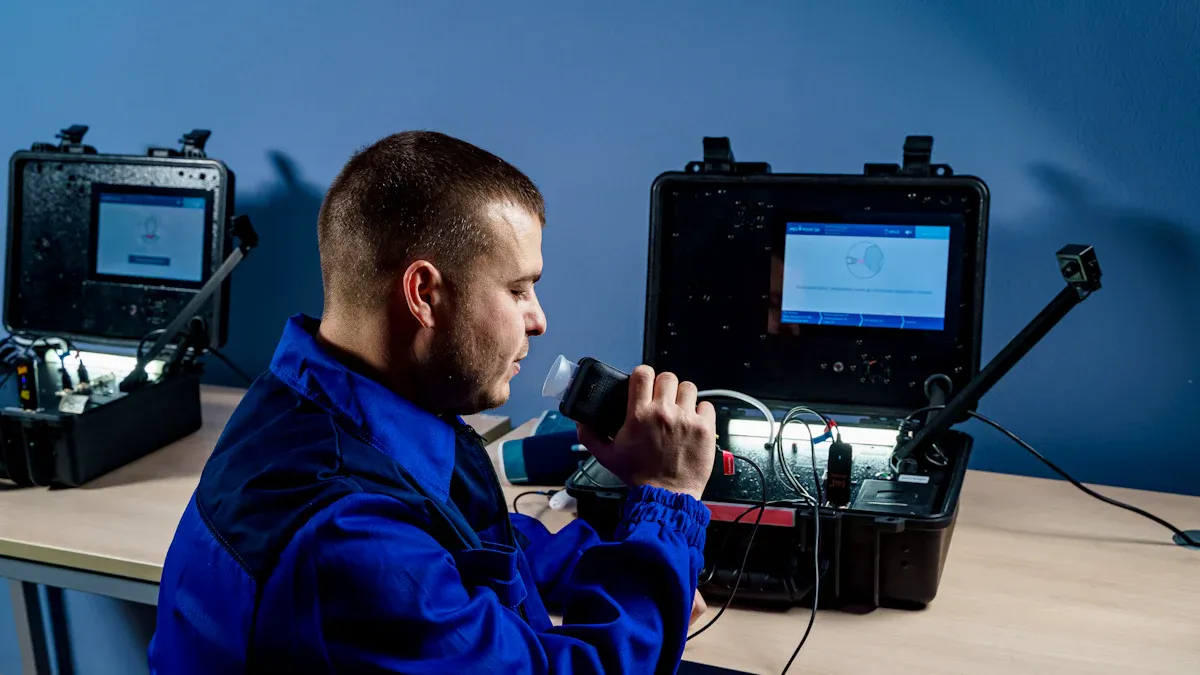The Evolution of Vending Machines: From Snacks to Smart Technology

You witness the evolution of vending machines every day, from ancient coin-operated devices to today’s smart technology. Early machines dispensed items like holy water and tobacco, while modern ones offer contactless payments and advanced user interfaces. The market for vending machines continues to grow.
Explore the changes in this table:
Year | Market Value (USD Billion) | CAGR (%) | Key Drivers |
|---|---|---|---|
2024 | N/A | Demand for contactless solutions | |
2032 | 34.88 | 7.30 | Consumer convenience, healthier options, smart technology |
2025-2032 | N/A | 7.30 | Urbanization, disposable income growth |
You see the journey from simple dispensers to intelligent machines that shape how you buy products.
Key Takeaways
Vending machines have evolved from ancient devices dispensing holy water to modern smart machines offering cashless payments and diverse products.
Smart vending machines enhance user experience with AI, personalized recommendations, and touchless payment options, making shopping faster and easier.
The market for vending machines is growing rapidly, driven by consumer demand for convenience, healthier options, and advanced technology.
Sustainability is a key focus, with modern machines using energy-efficient features and eco-friendly materials to reduce environmental impact.
Future trends include hyper-personalization, mobile interactions, and continued growth in the vending machine market, promising even more innovations ahead.
Evolution of Vending Machines

Ancient Origins
You might find it surprising that the evolution of vending machines began almost 2,000 years ago. In the first century, Hero of Alexandria invented a device for Egyptian temples. This machine dispensed holy water when you inserted a coin. The temple wanted to control how much holy water worshipers received, so Hero designed a clever system.
When you dropped a coin into the slot, it landed on a pan attached to a lever. The weight of the coin tilted the lever, opening a valve. Holy water flowed out for a short time. When the coin slid off, the lever returned to its original position, closing the valve. This process made sure everyone got the same amount of holy water.
This invention showed how people used technology to solve practical problems, even in ancient times. The evolution of vending machines started with a need for fairness and control.
Early Developments
You can trace the evolution of vending machines through many important milestones. After Hero’s invention, people in Ancient Rome used similar devices to dispense liquids like wine. By 1615, English taverns had coin-operated machines that gave out tobacco. These early machines helped people get products quickly and easily.
Take a look at this table to see how vending machines changed over time:
Time Period | Description |
|---|---|
Ancient Rome | The first known vending machine dispensed holy water or wine when a coin was inserted. |
1615 | Coin-operated machines in English taverns dispensed tobacco. |
1880s | The first vending machines appeared, dispensing postcards and books. |
1920s | Vending machines began dispensing a variety of products, including gum and cigarettes. |
1960s | Introduction of electronic components allowed machines to accept paper currency and offer refrigerated items. |
Modern Era | Smart vending machines with internet connectivity, cashless payments, and diverse product offerings. |
In the late 1800s, you could buy postcards from vending machines in London. By 1888, the first chewing gum vending machine appeared in New York City subways. These machines made buying everyday items faster and more convenient.
The first modern vending machines sold postcards in London in the early 1880s.
Vending machines spread to other countries, with the first U.S. machine selling chewing gum in 1888.
The evolution of vending machines continued in the 20th century. Automats opened in Berlin in 1895 and in the United States in 1902. These places let you buy food from vending machines, changing how people ate in cities.

You can see that each step in the evolution of vending machines brought new products and features. Machines started with simple liquids and moved to snacks, books, and even meals. The introduction of electronic parts in the 1960s allowed machines to accept paper money and keep items cold. Today, smart vending machines use the internet and cashless payments to make shopping easier for you.
The evolution of vending machines shows how technology and consumer needs shape the way you buy products. You benefit from faster service, more choices, and better convenience. As vending machines keep changing, you will see even more exciting features in the future.
Technological Advancements
Electronic Systems
You experience the benefits of electronic systems every time you use modern vending machines. These systems make machines smarter, safer, and more reliable. When you approach a vending machine, you notice how quickly it responds to your choices. The control board acts as the brain, managing payment, product selection, and dispensing. Display screens show you product details and transaction status, often using bright LCD or LED technology. Refrigeration units keep drinks and snacks fresh, while sensors monitor inventory and temperature.
Tip: Sensors help vending machines detect when products run out or when temperatures change, so you always get fresh items.
Electronic systems also improve security. Alarm systems discourage theft and keep machines working. Secure payment systems protect your money and personal information. Digital surveillance and monitoring capture evidence of any problems and allow quick responses to threats.
Impact on Security and Reliability | |
|---|---|
Alarm Systems | Serve as a psychological deterrent, preventing theft before it occurs and ensuring machines remain operational. |
Secure Payment Systems | Protect financial transactions from digital theft and fraud, ensuring safe and seamless customer interactions. |
Digital Surveillance and Monitoring | Provide comprehensive oversight, capturing evidence of breaches and enabling immediate response to security threats. |
You see how these technological advancements make vending machines safer and more dependable.
Common electronic components in modern vending machines include:
Control board: Coordinates payment processing and product dispensing.
Display screen: Shows product information and transaction status.
Refrigeration unit: Maintains freshness for perishable items.
Dispensing mechanism: Delivers products, using spiral coils or robotic arms.
Various sensors: Track inventory, temperature, and machine faults.
These features work together to give you a smooth and secure experience.
Cashless Payments
You notice that cashless payment systems have changed how you buy snacks and drinks. Modern vending machines now accept credit cards, mobile wallets, and contactless payment methods. You no longer need coins or bills. Instead, you tap your card or phone, and the transaction completes in seconds.
The adoption of cashless payment systems has grown quickly. Over the past decade, EMV-enabled transactions increased by more than 400%. More than 90% of consumers now use digital payments for vending purchases. Machines that accept cashless payments see up to 35% higher revenue.
Evidence Description | Statistic |
|---|---|
Increase in EMV-enabled transactions | Over 400% in the past year |
Consumer preference for digital payments | Over 90% of consumers using digital payments within a year |
Revenue increase for cashless machines | Up to 35% increase in average revenue |
You benefit from faster service and greater convenience. Cashless payment systems also make vending machines safer by reducing the risk of theft and fraud. You can trust that your transactions are secure.
Modern vending machines use digital displays and cameras to improve your experience. Digital screens show you product choices, prices, and promotions. Cameras help with customer service by sending live footage to support teams. They also keep you safe by monitoring the area and deterring theft. Some machines use facial recognition to secure transactions and offer personalized recommendations. Cameras linked to inventory systems help operators keep machines stocked and working well.
Smart Vending Machine Features
Smart vending machines use cutting-edge technology to make your experience better. You interact with touchscreens, voice controls, and interactive displays. These machines use AI and IoT to learn your preferences and suggest products you might like. When you return to a machine, it recognizes you and offers personalized choices.
Smart vending machines enhance convenience and personalization.
Touchscreens and voice controls make machines easy to use.
AI provides recommendations based on your past purchases.
IoT allows machines to send real-time data about inventory, sales, and maintenance.
Interactive touchscreens let you navigate menus easily.
Contactless payment options speed up transactions.
Recognition of returning customers enables personalized product suggestions.
The Internet of Things helps vending machines share data about product availability and sales trends. Operators use this information to manage inventory, reduce downtime, and respond quickly to your needs. You get the products you want, when you want them.
Smart vending machines also improve efficiency. AI and IoT help operators predict demand, optimize delivery routes, and stabilize revenue. Machines stocked with popular items sell more and waste less. IoT-enabled vending machines can lower operational costs by up to 20%. AI-driven inventory management can boost revenue by up to 25% in just two months.
Metric | Traditional Vending | With Smart Vending + AI |
|---|---|---|
Stock-outs & lost sales | Frequent, unpredictable | Reduced with demand forecasting |
Fuel & labor costs | Higher due to unnecessary trips | Lower thanks to route optimization |
Revenue consistency | Fluctuates with guesswork | Stabilized via better planning |
You see how smart vending machines use AI and IoT to make vending more efficient and profitable.
Manufacturers face challenges when adopting new technology. High costs, privacy concerns, and the need for constant updates make it difficult. Integrating new systems with old machines adds complexity. Companies must also follow strict regulations to ensure safety and reliability.
Evidence | Description |
|---|---|
Regulatory standards dictate the materials and design considerations for vending machines, ensuring user safety and product reliability. | |
Compliance Regulations | Adhering to compliance regulations minimizes risks such as costly recalls and legal issues, which can hinder technological advancements. |
UL Certification | Obtaining UL certification involves rigorous testing, ensuring that components can withstand high electrical loads, which is crucial for the implementation of advanced technologies in vending machines. |
You benefit from these efforts because you get safe, reliable, and innovative vending machines. As technology continues to advance, you will see even more features and improvements in the future.
Product Diversification
Beyond Snacks
You see vending machines everywhere, but they no longer just offer chips and candy. Today, you can find machines that sell fresh food, personal care products, and even prescription medications. This change makes vending machines more useful and increases accessibility for people with different needs. You might spot a vending machine with healthy snacks at your school or fresh sandwiches at the train station. These new choices help you get what you need quickly, especially when stores are closed or far away.
Vending machines now serve many purposes. You can grab a cold drink, pick up a phone charger, or buy hand sanitizer in seconds.
Here is a table showing how vending machines have expanded their product range:
Product Category | Description |
|---|---|
Fresh Food | Vending machines now offer fresh food options, catering to health-conscious consumers. |
Personal Care Products | Items such as skincare and hygiene products are now available, reflecting changing consumer needs. |
Electronics | Tech gadgets are being stocked, appealing to a tech-savvy demographic. |
Prescription Medications | Some machines provide access to medications, addressing specific health needs. |
Healthy Snacks | Options for nutritious snacks are increasingly available, catering to health trends. |
Specialty Beverages | Vending machines now include niche products like vegan and gluten-free beverages. |
Healthy and Specialty Options
You notice that vending machines now offer more nutritious choices. You can select fruit, nuts, or low-calorie drinks instead of only chips or soda. This shift matches your interest in healthier living and supports accessibility for people with special diets. The market for food vending machines is growing fast, with more machines providing fresh meals and snacks. You might see micro markets in offices or hospitals, giving you access to salads, wraps, and specialty beverages.
You find healthy snacks like granola bars and fruit cups in many locations.
Specialty options such as vegan drinks and gluten-free snacks are easy to access.
Micro markets let you choose from a wider range of fresh foods and prepared meals.
This variety helps you make better choices and improves accessibility for everyone, including those with dietary restrictions.
Electronics and Essentials
You rely on vending machines for more than food. In airports, you can buy earbuds or phone chargers when you need them most. Hotels offer travel-sized toiletries, and busy places like malls provide over-the-counter medications. These machines increase accessibility by giving you quick access to important items. You can pick up pens, notebooks, or even beauty products without searching for a store.
Electronics accessories like headphones and chargers are available in high-traffic areas.
Personal care items such as masks and hand sanitizer support your health and safety.
Essential products like medications and stationery make vending machines a valuable resource.
Modern vending machines give you more choices and improve accessibility in your daily life. You benefit from quick service and a wide selection, whether you need a snack, a tech gadget, or a health product.
Smart Vending Machines

User Experience
You interact with a smart vending machine and notice how easy it feels. Touchless payments let you buy snacks without handling cash. Voice recognition helps you make selections quickly. Interactive screens show you nutritional information and product recommendations. You see these machines in airports, hospitals, and schools, making fresh food available when you need it most.
In Tokyo, a smart vending machine for KATE makeup uses a camera to analyze your face. The AI suggests a palette of four eye shadow colors just for you.
You enjoy the convenience of getting what you want, when you want it. These machines work around the clock, so you never worry about store hours.
Personalization
A smart vending machine learns your preferences over time. When you buy snacks, the machine uses AI to remember your choices. It suggests products based on your past purchases. You get personalized customer interactions that make shopping more enjoyable.
Smart vending machines use data analytics to track what you buy.
IoT-enabled kiosks monitor inventory in real-time, so popular items stay stocked.
The machine predicts what you might want next, offering tailored options.
You feel valued because the machine understands your habits. This technology helps you discover new products that match your taste.
Operational Efficiency
Operators use smart vending machines to improve business results. Real-time tracking of stock levels reduces waste and keeps shelves full. Predictive analytics help plan inventory based on sales and local events. Cost savings come from lower overhead compared to traditional retail.
Metric | Description |
|---|---|
Machine Uptime | Measures how often the machine works, increasing profits by reducing downtime. |
Cost per Transaction | Shows how cashless payments and automated restocking save money. |
Monthly Net Profit per Machine | Reports over $1,600 monthly, showing strong performance. |
Sales per Machine | Gives instant feedback on which products sell best. |
Inventory Turnover Rate | Tracks how quickly items sell and get replaced, keeping food fresh. |
You see smart vending machines outperform older models in many ways. They offer better convenience, higher efficiency, and more reliable service.
Key Factors Driving Growth | Smart Vending Machines | Traditional Vending Machines |
|---|---|---|
Payment Methods | Cash Only | |
Operational Efficiency | IoT, Real-Time Data | Manual Management |
Consumer Convenience | 24/7 Availability | Limited Hours |
User Experience | Personalized, Interactive | Basic Functionality |
Retail Automation | High Efficiency | Labor-Intensive |
Sustainability
Energy Efficiency
You see vending machines everywhere, but you may not realize how much energy they use. Today, manufacturers design machines to save power and help the environment. You benefit from these changes because they lower costs and reduce pollution.
Many new vending machines use LED lighting. LEDs last longer and use less electricity than old bulbs.
Motion sensors turn lights on only when you approach, so machines do not waste energy.
High-efficiency compressors keep drinks cold while using less power.
Sleep modes and better insulation help machines avoid unnecessary energy use.
Modern cooling systems adjust based on demand, which means machines do not run all the time.
Coffee vending machines often heat water only when you need it, saving energy.
These features make vending machines smarter and greener. You help the planet every time you choose a product from an energy-efficient machine.
Tip: Look for vending machines with energy-saving labels. These machines use less electricity and support sustainability goals.
Eco-Friendly Materials
You can also support the environment by choosing products from vending machines made with eco-friendly materials. Manufacturers now use recyclable and biodegradable materials to build machines and package products.
Many operators select packaging that breaks down naturally or can be recycled.
This change reduces the impact of plastic waste on the environment.
Leading companies use recyclable materials in the machine’s frame and parts.
Machines built for durability last longer, so you see fewer replacements and less waste.
Products inside these machines often come in eco-friendly packaging.
You make a difference by picking items with green packaging. These choices help keep the planet clean and healthy.
Here is a look at how different countries focus on sustainability in vending machines:
Region/Country | Key Sustainability Initiatives | Market Characteristics |
|---|---|---|
Australia | Digital adoption, renewable energy initiatives | Growth driven by compliance regulations and consumer transparency |
South Korea | Government-backed smart city projects, investments in 5G and AI | Competitive market with a focus on digital innovation and sustainability |
France | Adoption of AI, IoT, and automation technologies | Strong focus on innovation and sustainability regulations |
You see that countries around the world work to make vending machines more sustainable. Your choices matter, and you help shape a greener future every time you use these machines.
Future Trends
AI Integration
You will see artificial intelligence changing the future of vending machines in many ways. AI-driven vending machines can understand what you like and suggest products that match your taste. When you return to a machine, it recognizes you and offers personalized recommendations. These machines use predictive algorithms to manage inventory and predict which products will sell best. You notice fewer empty shelves because AI helps operators restock more efficiently. Proactive maintenance powered by AI reduces downtime and repair costs. Cashless payment systems and dynamic pricing make your experience smoother and faster.
AI-powered vending machines provide personalized product suggestions.
Predictive algorithms help with maintenance and inventory management.
Cashless payments and dynamic pricing improve convenience.
You enjoy a shopping experience that feels more like e-commerce, with machines that remember your choices and offer products you want.
Mobile Interactions
You interact with vending machines using your smartphone more often now. Mobile payments and touchless technology make buying snacks and drinks easy and safe. You tap your phone or use face and voice recognition to complete transactions. Interactive touchscreen displays show you product details and promotions. Real-time inventory tracking means you always find your favorite items in stock. The demand for convenience and hygiene drives these changes, making mobile interactions a key part of the future of vending machines.
Cashless and mobile transactions are now standard.
Touchless vending technology increases confidence in hygiene.
Data analytics help operators restock machines efficiently.
Interactive screens engage you with marketing and product information.
You benefit from faster service and a cleaner experience every time you use a smart vending machine.
Industry Predictions
You will see the future of vending machines become even more advanced. Hyper-personalization will let machines offer products tailored just for you. Integration with digital advertising will bring new promotions and deals to your screen. Sustainability will remain important, with more machines using eco-friendly materials and energy-saving features.
Year | Market Value (USD) | CAGR (%) |
|---|---|---|
2025 | 17.73 billion | N/A |
2035 | 53.15 billion | 11.6 |
The U.S. vending machine market is valued between $8 billion and $9 billion in 2024. Experts predict a growth rate of 5-7% through 2030. North America holds over 40% of the market share. Intelligent vending machines will grow quickly, driven by cashless transactions and AI-powered personalization.
Hyper-personalization and digital advertising will shape the future.
Sustainability and eco-friendly practices will become standard.
The market will expand as technology improves and consumer needs change.
You will experience smarter, greener, and more personalized vending machines in the years ahead.
You have seen vending machines change from simple snack dispensers to smart, eco-friendly devices. Today, you expect cashless payments, healthy choices, and trusted brands.
Trend | Description |
|---|---|
Cashless Convenience | Over 80% of transactions are now cashless, showing your preference for mobile payments. |
Health-Conscious Choices | You look for protein bars and gluten-free snacks more often. |
Digital Reputation Matters | Machines with good online reviews sell better, proving trust matters. |
Smart technology and sustainability shape the future.
Companies that use green solutions grow stronger.
You will discover more innovations as vending machines keep evolving.
FAQ
What products can you buy from modern vending machines?
You find snacks, drinks, electronics, personal care items, and even fresh food. Some machines offer healthy choices, specialty beverages, and essential products like masks or chargers.
How do smart vending machines know what you like?
Smart vending machines use AI to track your purchases. They suggest products based on your buying habits. You get personalized recommendations every time you visit.
Are vending machines safe to use for payments?
You use cashless payment systems like credit cards and mobile wallets. These systems protect your money and personal information. Most machines have secure technology to keep your transactions safe.
Why do vending machines use energy-saving features?
Manufacturers add energy-saving features to reduce electricity use. You help the environment when you choose machines with LED lights, motion sensors, and efficient cooling systems.
Can you recycle packaging from vending machine products?
Many vending machines offer products in recyclable or biodegradable packaging. You support sustainability by choosing items with green packaging and using recycling bins nearby.
See Also
Vending Machines Have Transformed: Snacks to Smart Innovations
Smart Technology in Electronics Vending Machines Is Changing Retail
Cash Vending Machines Have Evolved: Coins to Digital Payments
Vending Machines Have Progressed: Coins to Contactless Transactions
